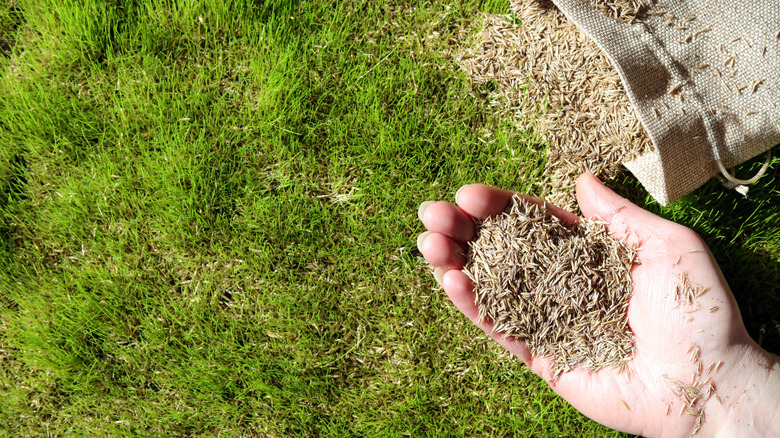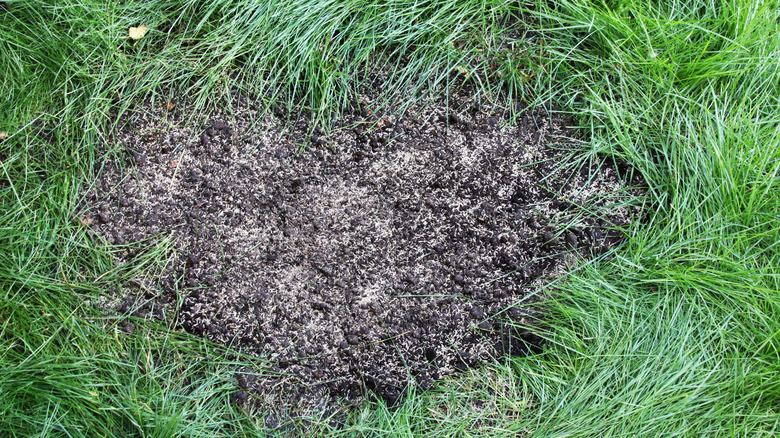Mistakes To Avoid When Using The Viral Toilet Paper Grass Seed Hack
In an ideal world, seeding a lawn would be a one-and-done activity. But in reality, bare spots can appear on your lawn from a number of causes, including dog urine, frost, rocks, spills, and more. That's where overseeding your lawn comes in, and different tactics abound. One that has recently taken over TikTok involves combining grass seeds with toilet paper to boost moisture retention. But it can go wrong if you use too much toilet paper or neglect to water adequately afterward. Even when done perfectly, it's not the ideal method for seeding an entire lawn.
In TikTok's toilet paper hack for spreading seeds, users soak toilet paper in water, add grass seeds, and apply the mixture to the lawn. The hack is supposed to be effective at keeping the seeds moist as well as protecting them from birds, with the toilet paper eventually dissolving. One TikTok user, @thelawntools, did an experiment and found that the hack initially seemed to work as well as a traditional method of seeding, which involves tilling the soil. But the results of the toilet paper method were noticeably patchier when the grass matured.
According to Rob Palmer, Brand President of Lawn Squad, there are several reasons this seeding technique may not be as effective as others. "In theory, it's not completely off base," Palmer told House Digest in an exclusive interview. "It can help the seed stay in place and hold some moisture, which is important for germination." But there are also a lot of ways it could go wrong. "The success of this method really depends on factors like seed-to-soil contact, sunlight, and proper watering," Palmer added.
Mistakes to avoid when using toilet paper as a carrier for seeds
In many TikTok videos showing this hack, people use an entire roll of toilet paper and dump seeds in without appearing to measure them. That alone is a potential point of failure, according to Palmer. "The most common mistake is using too much toilet paper, which can actually block sunlight and prevent proper soil contact," he told House Digest exclusively. "Another issue is uneven application — if the mixture is too thick or clumpy, seeds won't germinate properly." Both light and soil contact are essential for grass seed germination. The consistency of the toilet paper mixture may also depend on your toilet paper brand: Some are much thicker than others, and they have different levels of biodegradability.
Another potential mistake is not watering enough after seeding. Although the toilet paper retains moisture initially, grass seeds must stay moist on an ongoing basis, even after germination has begun, to survive into fully mature turf. You may need to water the seeds daily or even multiple times a day, depending on the climate and soil composition. "People [...] tend to underestimate how often the area needs to be kept moist; if it dries out, the germination process will stall," Palmer explained.
Another pitfall is attempting to use this method on a large area. "It might work somewhat for small bare patches, but we wouldn't recommend it as a reliable or scalable solution. While DIY methods can be creative, this one lacks the consistency and long-term effectiveness you get with professional patch repair products or overseeding methods," Palmer said.
Seeding techniques to try instead
Rather than using toilet paper to fill in your patchy lawn, Palmer said, "You're better off using a seed blanket or mulch-based patch repair product designed to retain moisture and protect seeds from wind and birds." Seed blankets are biodegradable mats that you place over seeded areas; some include grass seeds already embedded in the material. Patch repair products, on the other hand, are bagged mixes that contain moisture-retaining mulch, grass seeds, and sometimes fertilizer. With both products, all you have to do is measure, apply, and water. These products make seeding even easier than the toilet paper hack, and with more reliable results.
You can also make your own seeding mix sans TP. "A better DIY alternative is mixing grass seed with a bit of compost or topsoil, lightly raking it into the patch, and covering it with a thin layer of straw or a seed blanket," Palmer told House Digest exclusively. "These materials help with moisture retention and seed protection without compromising sunlight or soil contact. Plus, they're more in line with professional-grade methods." After seeding, remember to keep the soil moist and avoid mowing until the new grass is at least 4 inches tall.

